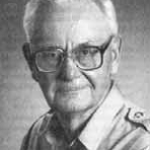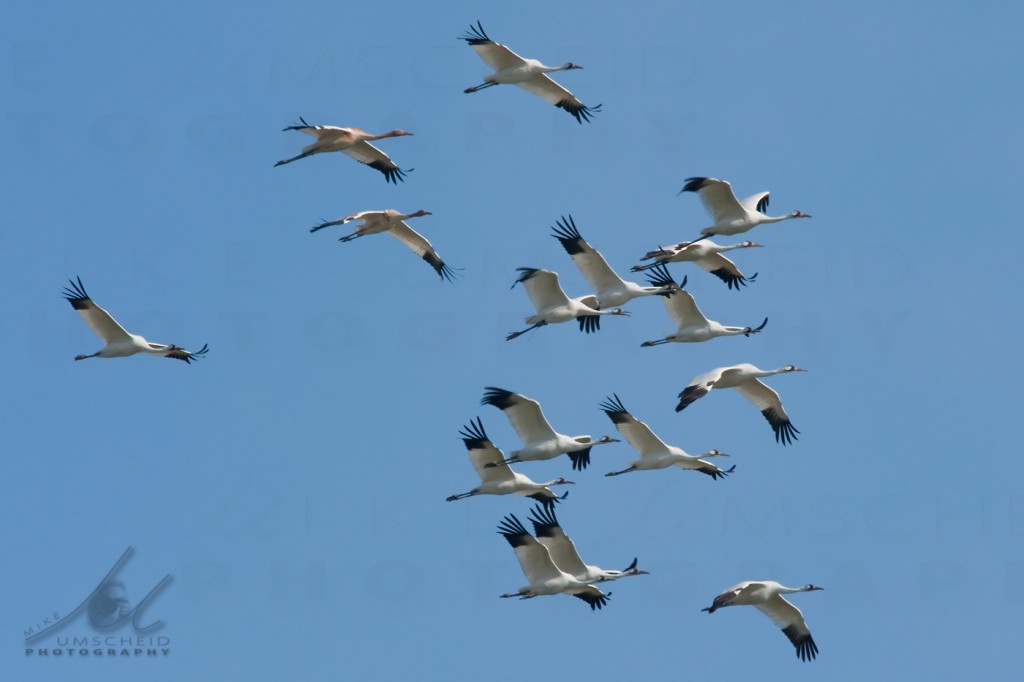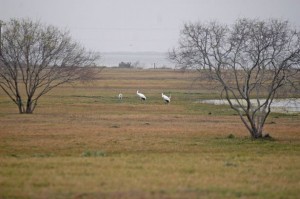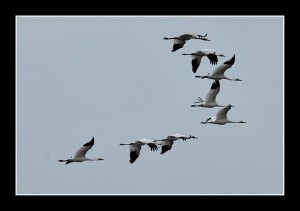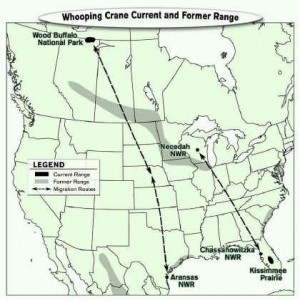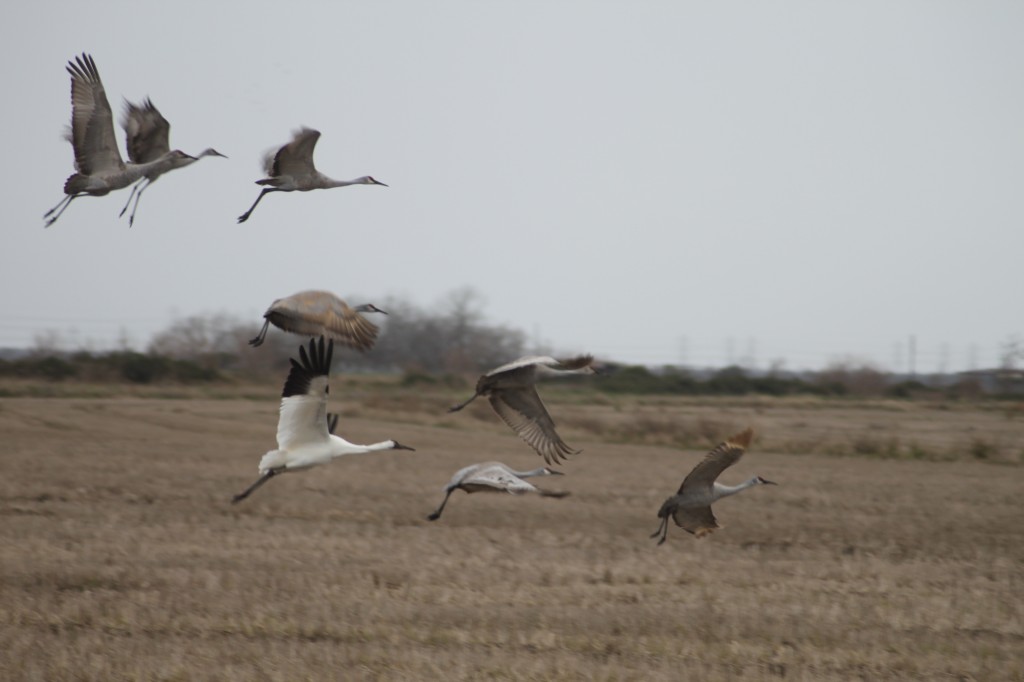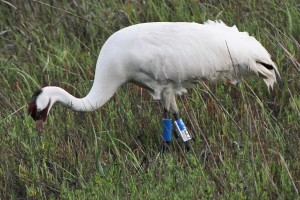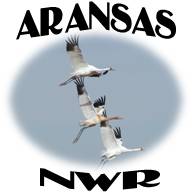Archive for the ‘Headline’ Category
Whooper Nesting Grounds Located (History)
January 2, 2013****History Briefs compiled by Whooping Crane Conservation Association****
Editor Note: For many years no one knew exactly where whooping cranes nested. Until 1954 whooping crane interests only knew that the birds migrated from “somewhere” in Canada to the Texas Coast. Crane interests had watched as the whooper population declined to 16 individuals in 1941. Pressures were brought on government agencies to protect and manage the birds. It was important to locate the whooper nesting habitats so these essential areas could be protected. In 1954 the whooping crane nesting area was finally located. The story is an interesting part of history. Whooping Crane Conservation Association member Pam Bates researched the literature and came across an article published in “Wild Lands Advocate” that tells the story. This is a follow-up to another article on our web page published on December 23, 2012. Click on the following link for the related story: https://whoopingcrane.com/whooping-cranes-from-despair-to-hope-to-progress/
DISCOVERY OF THE NESTING GROUND OF THE WHOOPING CRANE *
by Dr. W. A. Fuller
I have received a lot of credit for the discovery in 1954 of the only whooping cranes in Canada, but if it hadn’t been for the fire and an observant forester named George Wilson, I might never have gone out to identify the birds. The last nest of a whooping
crane had been seen in about 1926 in Saskatchewan. Members of the U.S. Fish and Wildlife Service (USWS) and others had searched from central Saskatchewan to the delta of the Mackenzie River without success. The USWS was interested because whoopers migrated to Texas.In 1945 I spent the summer working on fish in Lake Athabasca. At the end of the summer I decided that I would never return to the north. However, in 1946 I signed up to spend the summer at Great Slave Lake. The following winter I put together all the data that had been gathered over several years on the “Inconnu” (Stenodus leucichthys) and submitted the result as my masters thesis for the University of Saskatchewan. Convocation took place in early May.
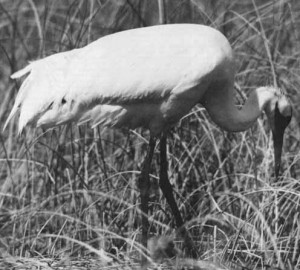
Whooping crane. (From a 1982 Hinterland Who’s Who brochure on the Whooping Crane written by E. Kuyt and published by the Canadian Wildlife Service)
A few days after the ceremony, I turned 23, and on the last day of May I married the young lady who is still my wife. I had previously applied for one of two jobs advertised by the federal government, and I was approved for the one based in Fort Smith, NWT. I found the north gets under your skin, and my wife Marie and I landed in Fort Smith on June 5. My duties centred on mammals in the south half of the Mackenzie District and in Wood Buffalo National Park (WBNP), part of which is in Alberta.In those days, the United States sent a bird guy, Bob Smith, and an assistant down to the Arctic Ocean. They flew out of Fort Smith for two or three days, and I usually took them up on their invitations to go on their sorties. Bob was a great guy, as well as a good pilot and a good bird man. Although waterfowl were the main target, they kept their eyes open for other birds, such as whooping cranes. As late as 1954 they had not made a sure discovery of whoopers, although on an earlier flight with them, one thought he had spotted a crane, but by the time Bob swung the plane around, whatever had been seen had disappeared.
In June 1954, a fire broke out in the northern part of Wood Buffalo Park. On June 30, the fire crew radioed to Fort Smith that one of their pumps was out of order. The forestry guy, George Wilson, went out to the site of the fire in a whirlybird piloted by Don Landells. I was in my office around 4:00 p.m. when a message came in from the plane to the effect that George and Don had seen a few big white birds, which they suspected were whooping cranes. Furthermore, Landells was to make another trip on the same route with a new pump, and if Bill Fuller was at the landing spot at 5:00 p.m he. could go back with Don and the pump.
Bill Fuller was at the landing and ready to go at 5:00 p.m. Don took us back on about the same route he had flown earlier, and we did see some large white birds, which were certainly whoopers. There were young birds as well as adults, so there was reason to believe that the nesting grounds were not too far away. I think we saw about nine birds on that first trip. I sent a telegram to the head office in Ottawa later that evening.
Ottawa’s reply the next morning asked me to keep an eye on the birds whenever there was a chance. I made several trips on an ordinary prop plane. On one such trip I counted thirteen birds, which was just over half of the birds (21, I think) counted in the Texas flock at that time.
The Whooping Crane Society and the USWS were very excited about the discovery, and soon there was talk about a ground survey in 1955. Canadian and American scientists would carry it out. However, the Canadian Wildlife Service (CWS) did not want to commit to that until there was proof of nesting, so I was to take a look next spring as early and as often as possible.
In those days, light aircraft landed on skis in winter and on pontoons in summer. The changeover was made in Edmonton in spring and fall, so it was difficult to find tansportation just when I needed it. While our government plane was in Edmonton, I got a ride with a pilot from Yellowknife on his way to Edmonton.I got another ride in a plane owned by the RCMP in Fort Smith. On that flight I saw what could only be a crane sitting on a nest. So the ground survey was on. Robert P. Allen of the National Audubon Society was to lead it. When Allen arrived in Fort Smith, we made one flight over the area so I could show him the location of the known nests.
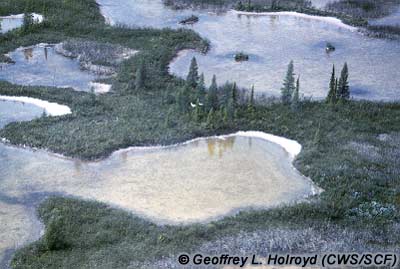
The nesting habitat of the Whooping Crane consists of marshes, shallow ponds, small creeks, and patches of wooded terrain and shrubs. Note two whooping cranes in the center of the photograph.
I made other flights, and I think I found a few more nest sites, but when the ground survey came on, I was at a conference in Alaska. The attempted ground survey is a story of its own.In 1956 I moved to Whitehorse in the Yukon, and Ernie Kuyt of the CWS took over work on the cranes. I had flown over the region of the first sightings a number of times. I had noted the tracks in the mud and searched my brains for a mammal that would make such a trail in the soft mud of the lake bottoms. Big birds never crossed my mind until I saw the cranes there in 1955.So who discovered the nesting ground? Wilson and Landells, who saw the big white birds? Me, because I saw young birds as well as mature birds on my sorties in 1955 and was also the first to see a female on a nest in the spring of 1956?It doesn’t really matter. The important point is that an important nesting ground was found. Each year for several more years, Ernie Kuyt found new nests. The total number of cranes in the Texas/WBNP flock has continued to increase in most, if not all, years since 1955.b
* Published in Wild Lands Advocate, The Alberta Wilderness Association, December 2004 • Vol.12, No. 6, pages 16 and 17.
Whooper Video
December 30, 2012Citizens Help Monitor Whooping Cranes
November 29, 2012By Chester McConnell, Whooping Crane Conservation Association
Whooping cranes, being our national symbol of conservation, create tremendous interest. All birders would love to have whoopers on their “life list”. Indeed, the average nature buff gets all excited when they are lucky enough to see a whooping crane. And you have got to be lucky or, for many, be willing to travel long distance to observe these magnificent, endangered birds.
They are the tallest bird in North America, standing nearly 5 feet tall, with a 7 foot wing span, so why are they so hard to find. Well, first there are only 405 known to be in the wild. And most spend several months nesting in the vast wetlands of northern Canada at Wood Buffalo National Park, a place very difficult to get to. Then when these approximate 266 Wood Buffalo birds migrate south in winter, the total Western flock will be scattered along a 200 mile wide by 2,400 mile long migration corridor. And about 139 birds in the Eastern flock will be stretched from Wisconsin to Florida and Louisiana. So this equates to a few whoopers in a vast area. Now you know why you have got to be lucky to spot some of these cranes.
But a lucky few do get to see the whoopers. We know because they report to the Whooping Crane Conservation Association on our web page by clicking on the link: https://whoopingcrane.com/report-a-sighting/ . Normally we receive about 130 reports annually. Our citizen observers report on whoopers located along the migration route from Saskatchewan, Canada to Aransas, Texas and from Wisconsin to Florida. We keep a map showing locations of the reports. Likewise some federal and state agencies also keep their records. Collectively, we attempt to gather as much information as possible to help protect and learn more about whooping cranes.
A number those reporting to the Whooping Crane Conservation Association sent us photos of their observations. One of the photos is shown below. To view more photos, click on the following link: Whooper photos 8 for web article 11-29-12
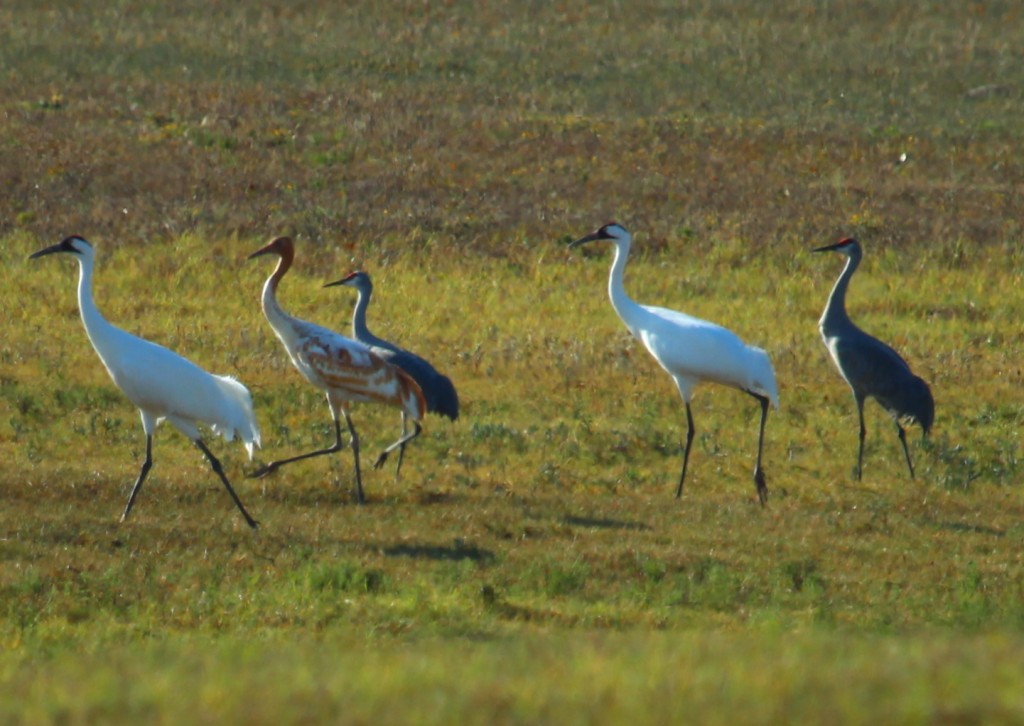
Two adults and one juvenile whooping crane with two sandhill cranes, Rock Port, Texas.
Photo by: Peggy Diaz
The best place to see whoopers is when they reach their winter habitat at Aransas National Wildlife Refuge along the Texas coast. You can ride along refuge roads and see some in fields and marsh land. Or you can climb the new tower on the Refuge and observe whoopers over a vast marsh area. But possibly the best way to observe them is to get on one of the commercial boats at Rockport, TX and ride out to make your observations.
Send Season’s Greetings by Whooper
November 18, 2012This Holiday Season, or for any other special occasion, why not send a Whooper eGreeting?
Select from one of 9 designs in our Greeting Card Gallery.
If your friends, family and loved ones don’t have email, don’t worry – simply print out this DIY Whooper Christmas Card, pop it in an old-fashioned envelope and mail them a reminder that you are thinking about them and that they should be thinking about Whoopers!
Folding Instructions
Print the Whooper Christmas card and place it face down with the Whooper Picture facing away from you.
Fold in half by taking the bottom edge of the paper to the top making a nice even crease. If you are using think paper you may need to score the crease with a knife (careful not to cut all the way through).

Turn the card around so that the Whooper Picture is nearer to you, but still facing down.
Again, bring the bottom edge up to the top making a strong fold. Use the back of a spoon or a ruler to press along the crease if required.
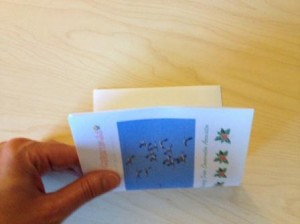
Your card should now be ready for you to fill in your greeting. If the paper is thin you may need a little paper glue or double sided tape to make it look better.
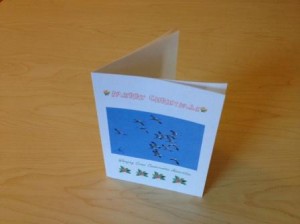
Happy Holidays, and don’t forget – a WCCA Membership Subscription makes a great gift.
Rare Whooping Crane Photo
November 13, 2012by Chester McConnell
Whooping Crane Conservation Association
Getting good photographs of members of the Aransas-Wood Buffalo flock of whooping cranes is not easy. First they are wild and cautious. And then there are so few of them (about 300). Generally they are in locations not easy to get to. During this time of year the whoopers are migrating from their nesting habitat in Wood Buffalo National Park, Canada to Aransas National Wildlife Refuge along the Texas coast. They may be observed anywhere along the 2,400 mile migratory route if you are lucky.
Photographer Mike Umscheid is one of those lucky people but I believe that his luck improves the harder he works. Mike recently made some excellent photos of whooping cranes and agreed to share them with the Whooping Crane Conservation Association (WCCA).
Mike’s photo shown below is very unusual because there are 16 whoopers flying together. Two more were with the group. Normally whooping cranes fly in groups of 2 to 8, so a photograph of 16 together is very unlikely.
WCCA communicated with Mike and we share with you his excitement about his recent encounter with the cranes. Mike advised: “I’ve visited the WCCA website before, even before I photographed those cranes, in gathering information on movement of the whoopers, the latest flock numbers, etc. I’ve fallen in love with the whooping crane and it is a bird that I have always wanted to photograph. Needless to say, it was an absolute treasure being around them and having them fly above me (let alone photographing them).”
Mike continues: “I was out at Quivira (National Wildlife Refuge, Kansas) photographing cranes for a couple of days recently. The surge of cranes began to arrive there earlier last week. The whooper numbers peaked at 18, and all 18 of them were on the Little Salt Marsh (LSM) at that time. The day before, my partner (Jim Glynn), and I photographed 3 whoopers as they flew just about directly overhead as they lifted off to feed around 10:30 in the morning. I got some fairly nice nearly frame-filling images of these birds in flight.” (WCCA has omitted the specific times and locations of the whooping cranes to help prevent possible harassment of the birds. Most whooper visits occur overnight and are gone from the area by mid-morning the next day.)
After photographing the many sandhills on Big Salt Marsh (BSM), Mike and Jim slowly made their way to another site to see if they could observe the whoopers again. Sure enough, they located them again way out in the middle of a marsh. Mike explained: “At first there were two subgroups of 13+5, but then they all converged before taking flight to head south. The 16 adults and 2 juveniles took flight, a scene I’ll never forget. We were repositioning ourselves as they lifted off, so I didn’t get any images of the lift off, as the flapping, stark black wing tips were lined up one by one like a series of aircraft departing off a runway. We grabbed some amazing in flight shots in good front light as they were flying towards us — all 18 of them!”
Mike added, “In several of my images, I noticed one adult did have a GPS tracking unit on one of its legs and was banded. All the other birds were device/banded free. It was a moment I never anticipated I would get to experience, and I have only had my 600mm lens for less than a month! All my in-flight images were shot with a Nikon D3, 600mm f/4 lens with 1.4x teleconverter.
USFWS Whooping Crane Meeting Video
November 7, 2012by Ron Outen, Regional Director, The Aransas Project
On the evening of October 24, TAP attended a second public presentation by USFWS on the new distance sampling methodology being used at Aransas National Wildlife Refuge. Refuge Biologist Brad Strobel again presented his Powerpoint presentation for a small audience. TAP captured the presentation on video presentation on video, and has also posted the PowerPoint presentation to the TAP website Note that this PowerPoint is from the Oct. 4, 2012 presentation, but the content is essentially the same one used at the Oct. 24, 2012 presentation (minor changes included new slides with staff bios, current conditions).
At the meeting, Strobel reported that USFWS is currently planning to conduct additional flights this season beyond the three flights conducted last season, as well as potentially making additional adjustments in the protocol such as flying narrower transects than the current transect of 1,000 meters.
Refuge staff reported on the current conditions on the winter range, which has been posted to the Aransas National Wildlife Refuge website in the first Whooping Crane Update of the season.
TAP Files Response to Defendants’ Motion to Reopen Case
Shortly following the issuance of the “Aransas-Wood Buffalo Whooping Crane Abundance Survey (2011-2012)” by USFWS on October 3, the defendants in TAP’s lawsuit under the federal Endangered Species Act filed a motion seeking to reopen the record in the case (9 months after the trial of the case) to introduce the Abundance Survey into the record.
Last week, TAP filed its Plaintiff’s Response to Defendants’ Motion to Reopen Case opposing the motion of the defendants’ to reopen the case. TAP has posted its response to the TAP website for the benefit of TAP’s members and members of the public seeking to remain informed about the case.
Whooping Cranes Continue Migration South
October 27, 2012By Chester McConnell, Whooping Crane Conservation Association
Whooping cranes are on the move southward and have been spotted all along the migration pathway. The Whooping Crane Conservation Association has received reports of cranes along their migratory path from Saskatchewan, Canada to Aransas, Texas.
Martha C. Tacha, U.S. Fish and Wildlife Service, Nebraska reports that, “The whooping cranes with GPS transmitters are on the move, with the bulk of these marked cranes in North Dakota and South Dakota, and two already in Texas. We know that one unmarked whooper stopped over at a lake near Oklahoma City recently. While the early confirmed sightings have been single birds, there was a group of nine adult-plumaged whoopers in northern North Dakota recently.”
One of the GPS transmitter marked whooping crane arrived on the Texas coast on October 18 and has been using the marsh habitat extensively. Aransas National Wildlife Refuge officials report that, “All other GPS marked whooping cranes are north of South Dakota awaiting favorable migration conditions. Biologists expect the cranes will take advantage of the strong north winds associated with seasonal cold fronts. On October 23 Aransas Refuge Biologist Brad Strobel and Refuge Manager Dan Alonso observed one adult whooping crane feeding in the refuge marshes on the Blackjack peninsula. The bird ate at least two prey items during the 3-5 minutes it was observed.
The winter home of the whooping cranes at Aransas Refuge is improved compared to this time last year. Refuge personnel advise that salinity levels in the bay waters are fresher than they were at this time last fall and winter. The salinity levels in San Antonio Bay were recorded as 23.9 parts per thousand.
Aransas Refuge also has experienced improved rainfall in recent months. According to refuge officials, to date, the refuge has received 25.6 inches of rain, which is a foot more than we had last winter at this time. The area is still unusually dry but the National Oceanic and Atmospheric Administration predicts south Texas will see a wetter than average winter and spring in 2013. To make certain freshwater is available to the whooping cranes when they arrive, refuge staff have been working on water well sites previously used by cranes on the Blackjack peninsula to ensure they are in good working condition.
Whooper food sources on the refuge have also improved during this growing season. Refuge biologists have noticed many flowering and budding wolfberry plants while conducting field work during the last few weeks. Wolfberry conditions in the marsh appear to be much better than this time last year. Peak berry abundance typically occurs in November and December and the plants seem to be on schedule according to biologists. Blue crabs also appear to be abundant in the marsh currently based on surveys conducted by refuge personnel.
TAP Urges Attendance at Whooping Crane Count Meeting
October 22, 2012by Ron Outen, Regional Director, The Aransas Project
The U.S. Fish and Wildlife Service will hold a second Public Meeting at Aransas National Wildlife Refuge on Wednesday, October 24th. The public is urged to attend to learn about the Service’s new method to count whooping cranes.
It was truly gratifying to see the great outpouring of support for and interest in the whooping cranes from the Rockport community at the October 4th presentation by USFWS on the new distance sampling methodology being used at Aransas National Wildlife Refuge. The questions asked by the audience demonstrated again that the Aransas-Rockport area is one of the most knowledgeable and engaged communities anywhere, especially when it comes to the whooping crane.
We hope that folks who attended that first public presentation, as well as others who may have been unable to attend, will attend a second public presentation being offered by USFWS: 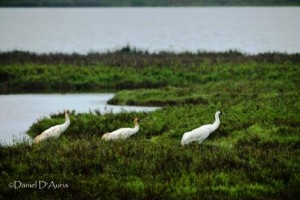
Wednesday, October 24, 2012
6 to 8 p.m.
Aransas National Wildlife Refuge
(six miles south of Austwell on Farm-to-Market Road 2040)
Because USFWS issued its Aransas-Wood Buffalo Whooping Crane Abundance Survey (2011 – 2012) only one day before the October 4 briefing, this is a great opportunity to ask further questions of Aransas Refuge staff after having had more opportunity to review the report, or simply to ask questions that you didn’t get a chance to ask last time.
Video of October 4th presentation Available Online:
The Aransas Project has posted a video documenting the two-hour public presentation by the U.S. Fish and Wildlife Service on the distance sampling methodology in use at the Aransas National Wildlife Refuge during the last wintering season. The presentation was held on Oct. 4, 2012 in Fulton, and includes the formal presentation as well as questions from the audience following the presentation. While there was a great crowd on hand with many well-informed questions, we know that many people were not able to attend. We hope that this video documentation is helpful to the whooping crane community around the world in staying informed on this critical issue.
As you can see in the next article below, the defendants in TAP’s litigation have sought to supplement the record with USFWS’ Oct. 3 report, which is critical of Stehn’s methodology. We think that you will find that the tone of the presentation captured in the video differs significantly in its characterization of Stehn’s work from that of the written report released by USFWS one day prior to that public meeting. It also gives you a great sense of the strong level of public engagement on this issue.
Defendants Seek to File USFWS Report in TAP Litigation:
Judge Will Not Admit Without Full Evidentiary Hearing to Probe Credibility
As reported recently by Matthew Tresaugue of the Houston Chronicle, TAP supporters should also be aware that the State of Texas, the Guadalupe-Blanco River Authority and other defendants have sought to introduce USFWS’ Oct. 3 report into evidence more than 9 months after the close of the trial in TAP’s lawsuit under the Endangered Species Act. The Oct. 3 report criticizes the previous census method and introduces USFWS’ new statistical modeling method of estimating peak flock size. The previous census method was used since 1982 by USFWS’s own prior Crane Coordinator, Tom Stehn. Stehn’s work led the recovery and survey of this species until he retired in September 2011.
The federal district judge presiding over the case has indicated that the report will not be admitted into evidence without a full evidentiary hearing at which the authors of the report from USFWS are available would be required to testify. Read more about this development.
Crane Migration Back to Texas Coast Underway:
All of us who love the cranes are excited that the annual migration back to the Texas coast from the summer nesting grounds in Canada is underway. In a blog post entitled, “Whooping Cranes Migrating South to Texas” https://whoopingcrane.com/whooping-cranes-migrating-south-to-texas/ , Chester McConnell of the The Whooping Crane Conservation Association reports that the cranes had a successful summer nesting season. Check out Chester’s post to learn more about estimates on the number of cranes expected to arrive at the Refuge.
The Victoria Advocate Editorial Board also issued an editorial on the return of the cranes, encouraging residents to visit the Refuge to see the cranes and noting significantly that:
In a way, the cranes are protecting us as well. Their protected status limits the amount of water that can be taken from the rivers feeding into the refuge in order to maintain the correct balance in the estuary that houses the cranes’ major food source. While this may be an inconvenience for some area industries, it ultimately protects our waters from being siphoned away from our area, keeping it here to meet the needs of area residents and wildlife.
While all of us in the Coastal Bend need no reminder of the critical link between our well-being and that of the cranes, it is encouraging to see this message from the Advocate’s Editorial Board.
Thanks so much for your continued support. Please feel free to forward this on to a friend.
Whooping Cranes Migrating South to Texas
October 17, 2012by Chester McConnell, Whooping Crane Conservation Association
They are on their way! The whooping cranes have departed from their Wood Buffalo National Park nesting grounds in Canada and are migrating towards Aransas National Wildlife Refuge on the Texas coast. For many thousands of years the endangered cranes have made this annual 2,400 mile migration. It is one of nature’s wonders.
The Whooping Crane Conservation Association has received dozens of reports of whoopers from birders in Alberta and Saskatchewan, Canada and North Dakota, Nebraska and Texas. Approximately 300 whoopers are expected to arrive at Aransas Refuge by late November. Hopefully the thirty-four (34) juvenile cranes that were observed on the Canadian nesting grounds will all make it to Texas with the adult birds.
During the nesting period in May sixty six (66) whooping crane nests were discovered by the Canadian Wildlife Service. Three months later in August, an additional three (3) family groups were identified indicating that there were at least sixty-nine (69) nesting attempts during the 2012 nesting season. In early August, just prior to fledging, thirty-four (34) young including two (2) sets of twins were observed on the breeding grounds. Ten of the young whooping cranes were marked with leg bands and satellite transmitters so details about their migration can be learned.
Whoopers usually follow a migratory path through Saskatchewan, North and South Dakota, Nebraska, Kansas, Oklahoma and Texas. In central Texas they fly near cities such as Wichita Falls, Fort Worth, Waco, Austin, and Victoria. During migration they often pause overnight to use wetlands for roosting and agricultural fields
They nearly migrate in small groups of less than 4 to 6 birds, but they may be seen roosting and feeding with large flocks of the smaller sandhill crane. They are the tallest birds in North America, standing nearly five feet tall. They are solid white in color except for black wing-tips that are visible only in flight. They fly with necks and legs outstretched. Hunters are urged to learn to identify whooping cranes to avoid mistaking them for some other birds.To help identify whooping cranes, please click on the following link: https://whoopingcrane.com/whooper-identification/
Since beginning their slow recovery from a low of 16 birds in the 1940s, whoopers have, with few exceptions, always wintered on the Texas coast on and near Aransas National Wildlife Refuge. However, in the winter of 2011-12, several groups of whooping cranes expanded their wintering areas to include more coastal areas and even some inland sites in Central Texas, Kansas and Nebraska—patterns that surprised crane biologists. Texas has initiated the “Texas Whooper Watch” program that asks the public to help us discover more about where whooping cranes stop in migration and to be ready to learn more about these potential new wintering areas. The Whooping Crane Conservation Association and Texas will share information collected about whoopers from birders to improve our knowledge about the birds.
The Whooping Crane Conservation Association is hopeful for a much better winter season on Aransas Refuge. As most whooping crane interests know, last winter on the refuge was abnormal in several respects, including severe drought conditions and poor food availability. Some of the cranes spent some or all of the winter away from Aransas making accurate counts of the birds impossible. During the past several months, the Aransas area has received more rain and habitat conditions are improved. Blue crab numbers have rebounded along the Aransas Refuge coast and the returning whooping cranes will, at least, start out with a good food supply. Hopefully the wolfberry crop will improve and be another source of food.
Nesting Success Good For Whooping Cranes In 2012
October 8, 2012by Chester McConnell, Whooping Crane Conservation Association
Whooping crane nesting success on Wood Buffalo National Park, Canada during 2012 was considered good but slightly down from previous years. This is good news after the poor winter season on Aransas National Wildlife Refuge in Texas.
Sixty six (66) whooping crane nests were discovered in May by the CanadianWildlife Service. Three months later in August, an additional three (3) family groups were identified indicating that there were at least sixty-nine (69) nesting attempts during the2012 nesting season. In early August, just prior to fledging, thirty-four (34) young were observed on the breeding grounds. Two (2) sets of twins were observed. Ten of the young whooping cranes were marked with leg bands and satellite transmitters.
Martha Tacha, U.S. Fish and Wildlife Service reports that: “The whooping cranes began moving down into staging areas in Saskatchewan last month; a week ago about half of the GPS-marked cranes were in Saskatchewan. There are currently 30 whooping cranes carrying working GPS transmitters, and likely a hand-full of marked cranes with colored leg bands from 1978 to 1988 marking effort. As of this morning (Oct.5), there were no GPS-marked cranes in the United States except for one young whooper in Burke County, in extreme northwest North Dakota (this bird was also observed independently by biologists on the ground on and after September 22, 2012). However, I have also received confirmed, probable, and several unconfirmed reports of whooping cranes observed as far south as southcentral North Dakota, so apparently at least one or two whooping cranes without GPS transmitters have moved farther into the northern reaches of the U.S. Flyway.” Citizen birders have also reported to the Whooping Crane Conservation Association of their observation of whooping cranes in Saskatchewan and North Dakota.
The Whooping Crane Conservation Association is hopeful for a much better winter season on Aransas Refuge. As most whooping crane interests know, last winter on the refuge was abnormal in several respects, including severe drought conditions and poor food availability. Some of the cranes spent some or all of the winter away from Aransas making accurate counts of the birds impossible. During the past several months, the Aransas area has received more rain and habitat conditions are improved. Blue crab numbers have rebounded along the Aransas Refuge coast and the returning whooping cranes will, at least, start out with a good food supply. Hopefully the wolfberry crop will improve and be another source of food.
The retirement of Tom Stehn last year resulted in a change from a direct count method to a transect-based survey of the greater Aransas NWR area to estimate the number of whooping cranes wintering there. Therefore, the official estimate of 254 whooping cranes wintering at Aransas last winter is not comparable to previous years’ estimates of flock size. There was much optimism that a record three hundred (300) whoopers would be counted on Aransas Refuge in 2012, but due to the unusual movements of the cranes and the new census method, the accurate number will never be known. Hopefully, this winter will be more typical in terms of crane distribution and Aransas Refuge biologists will be successful in making an accurate count.
